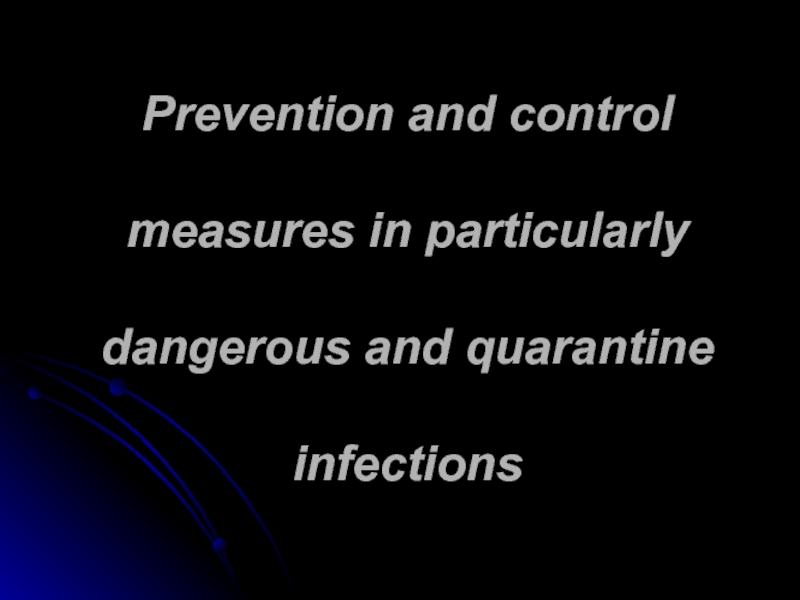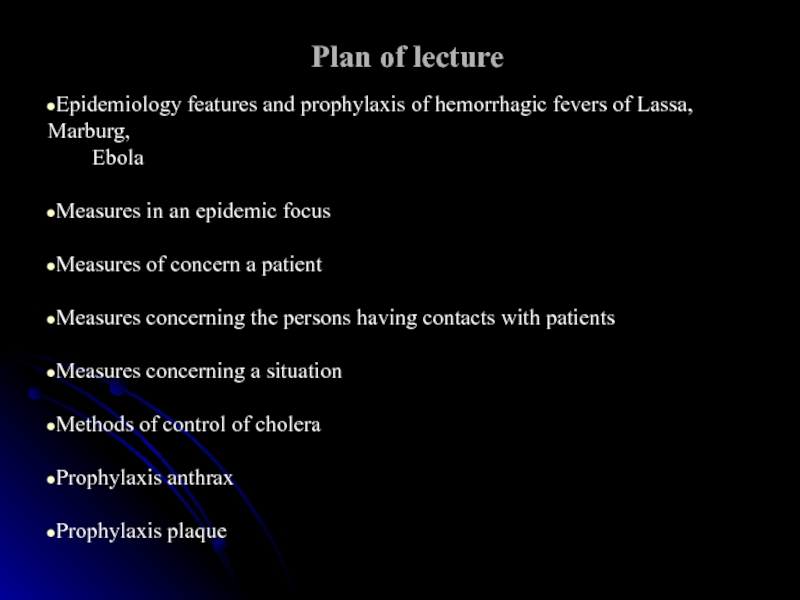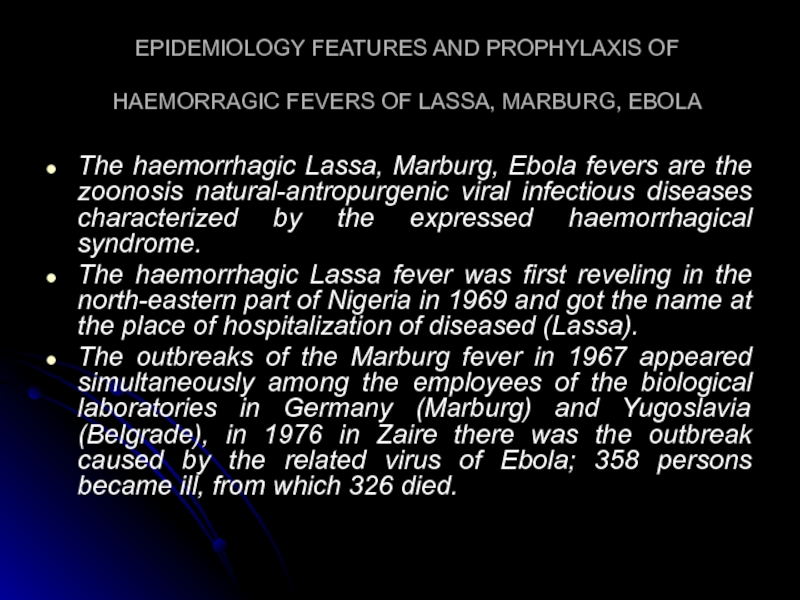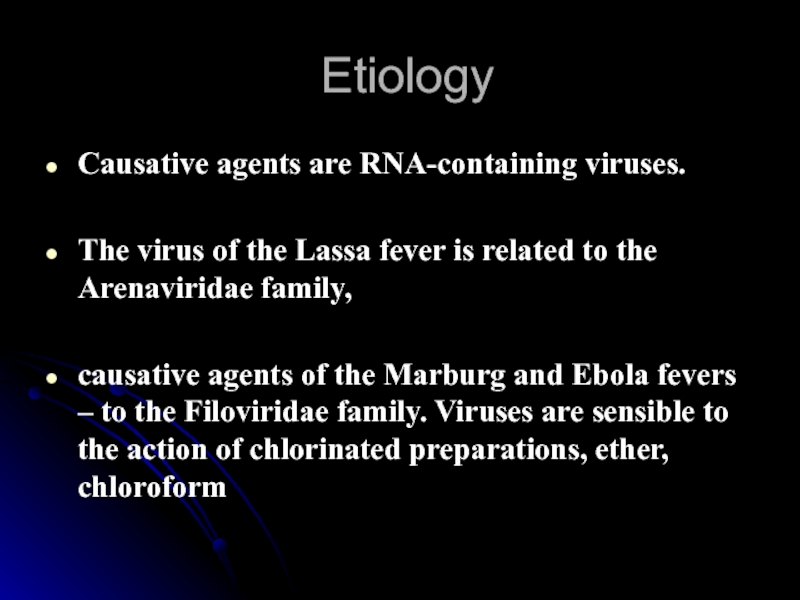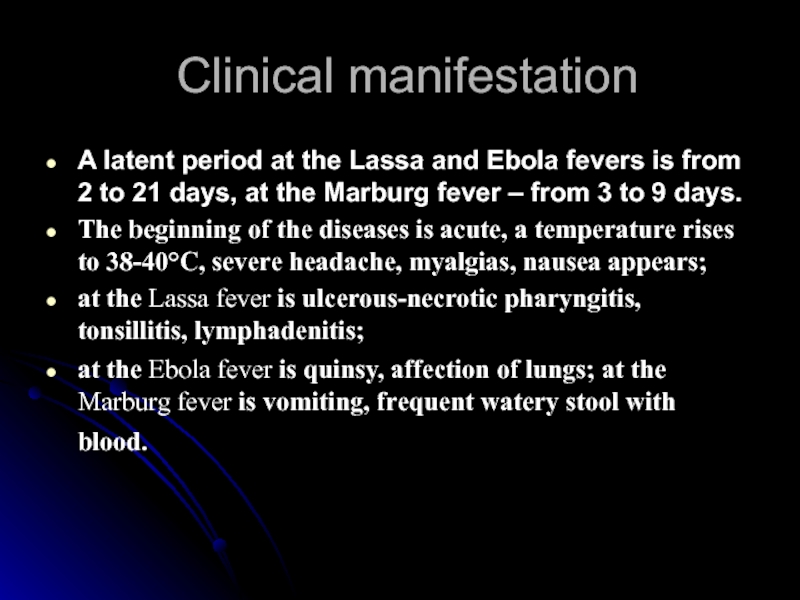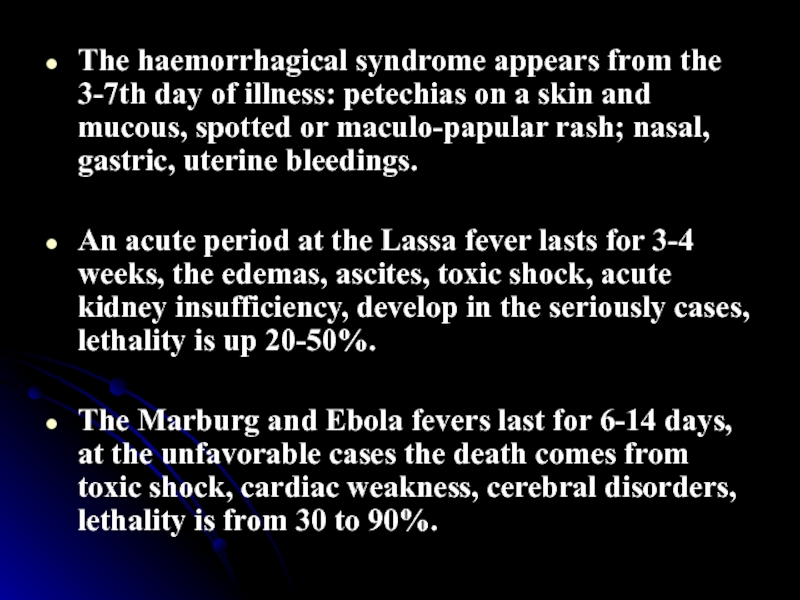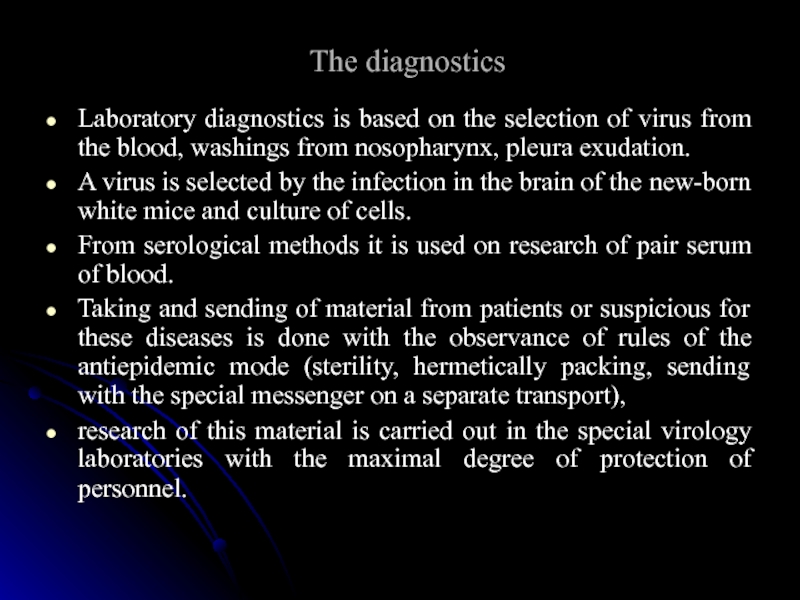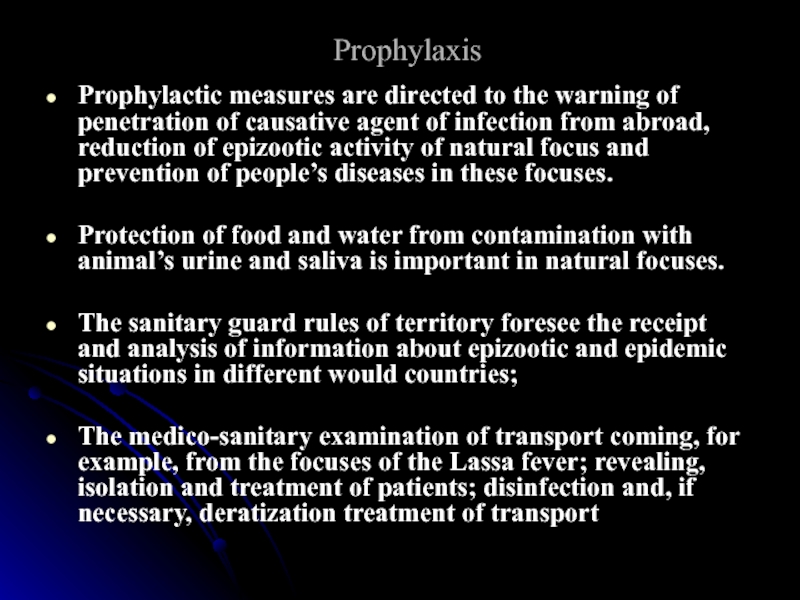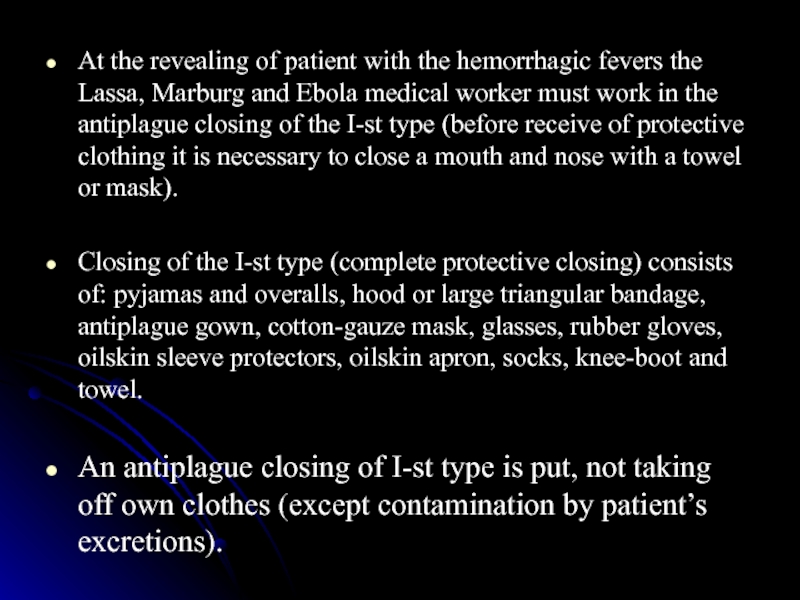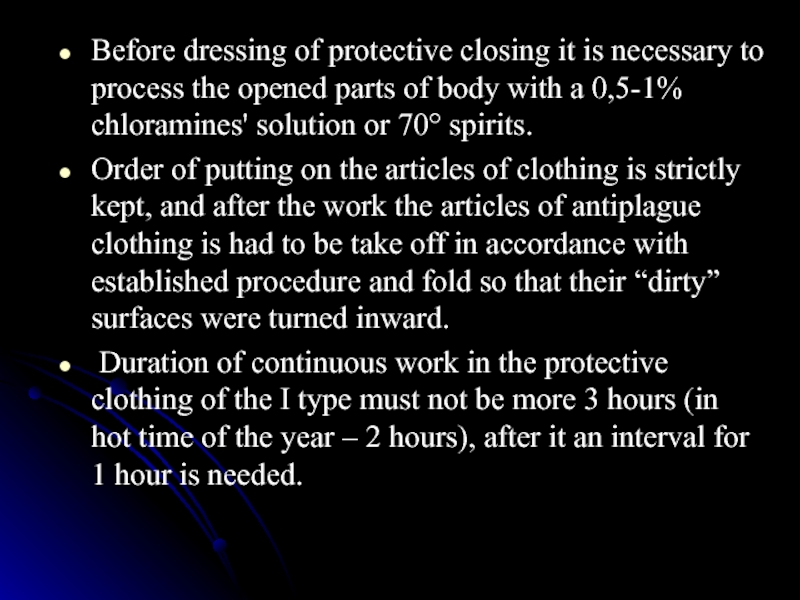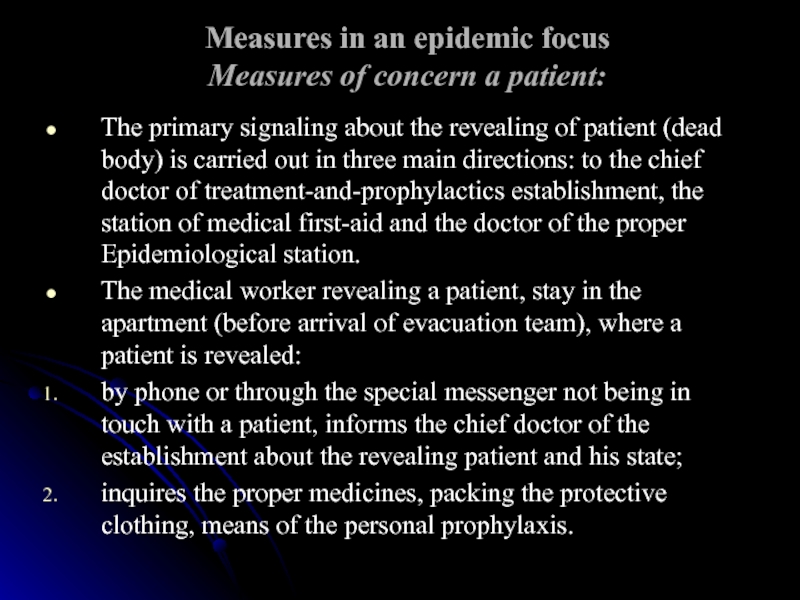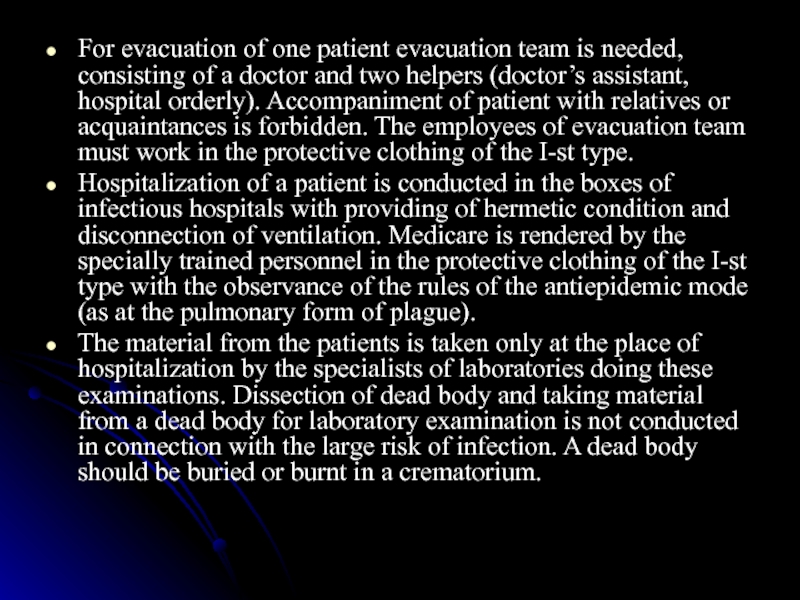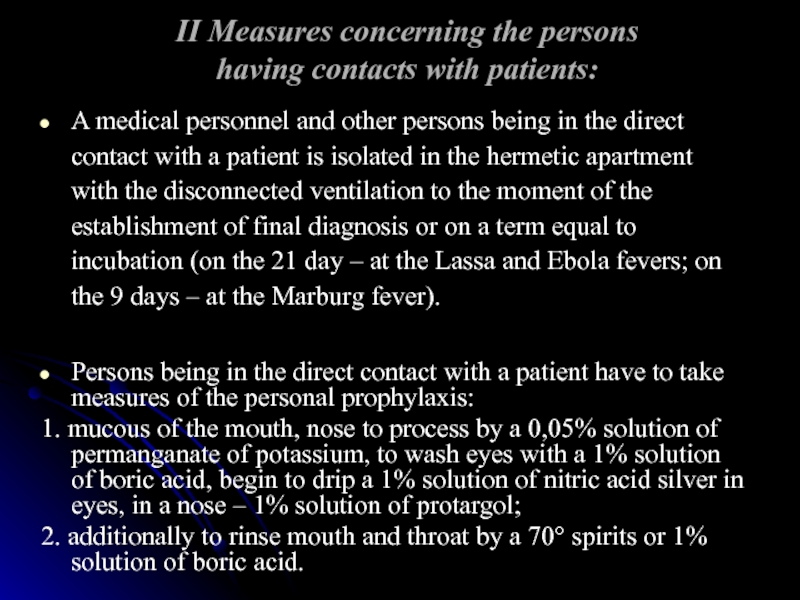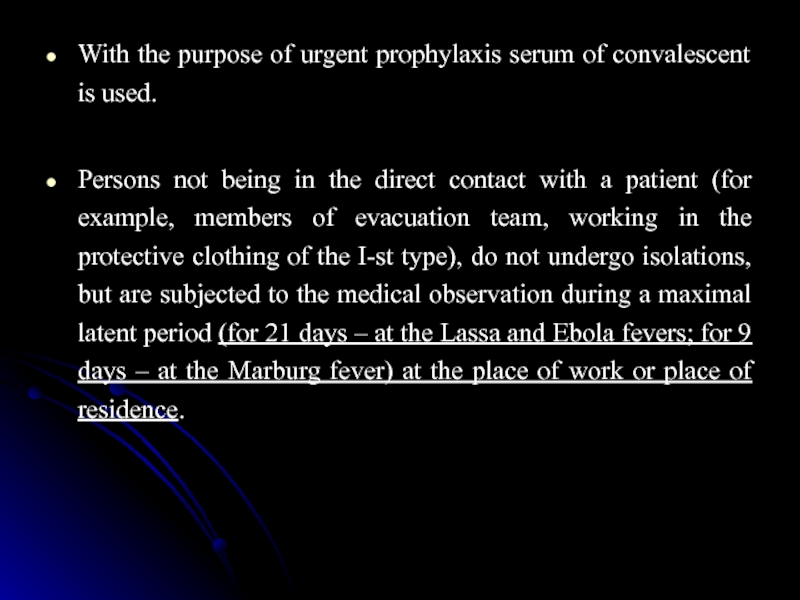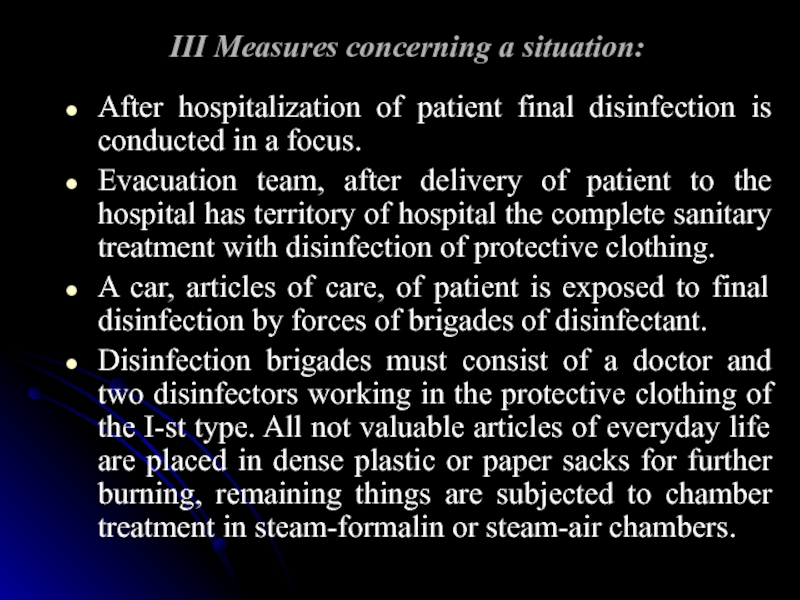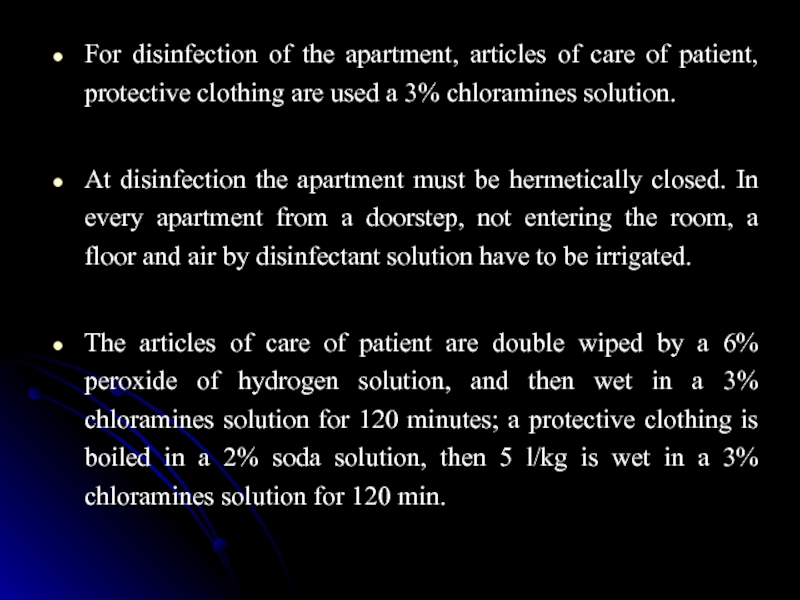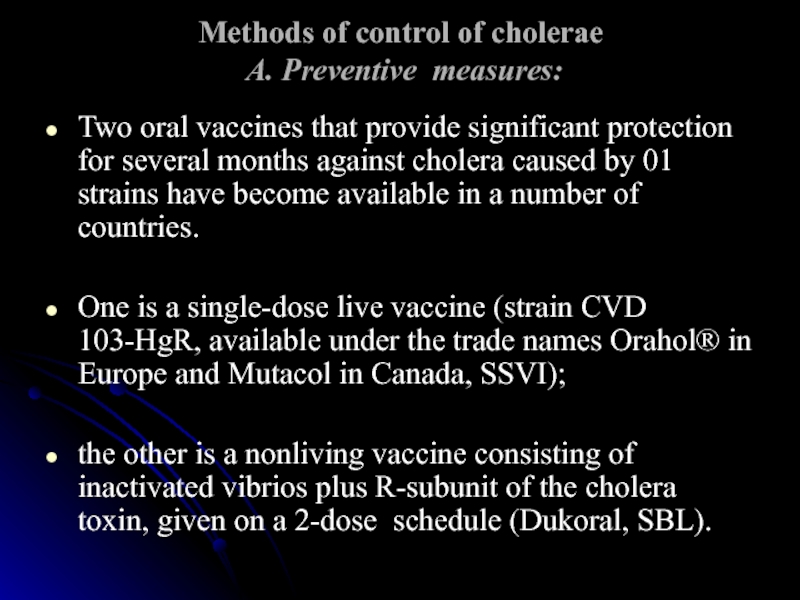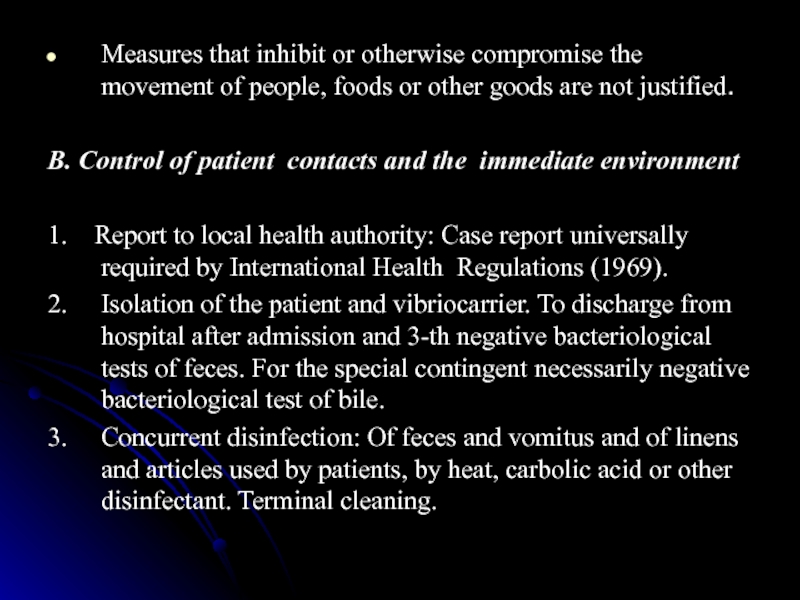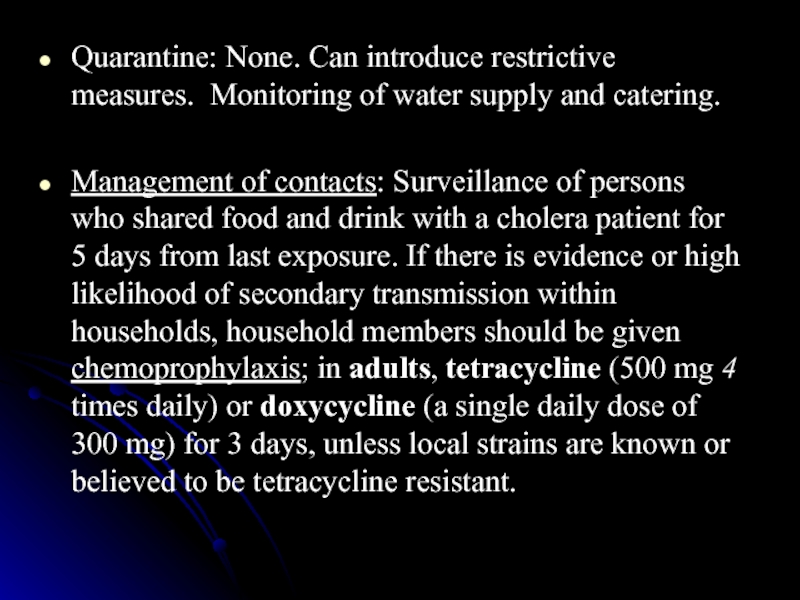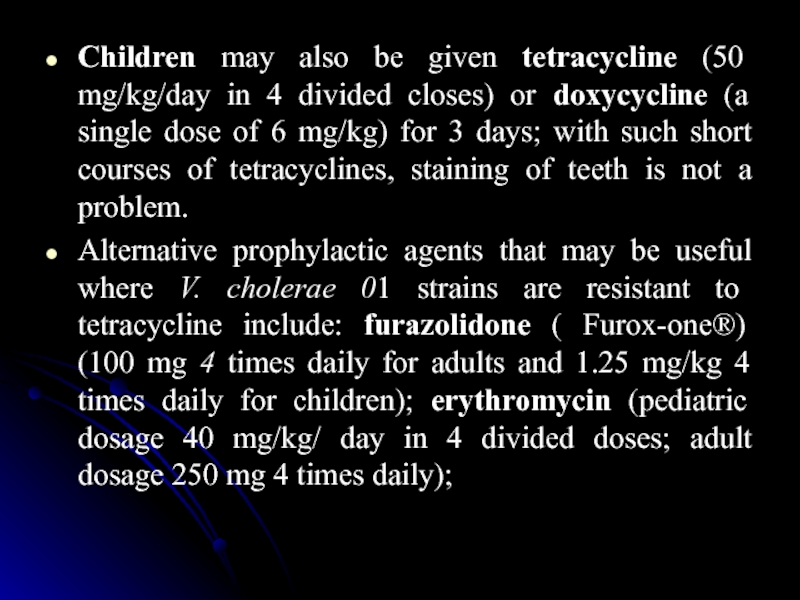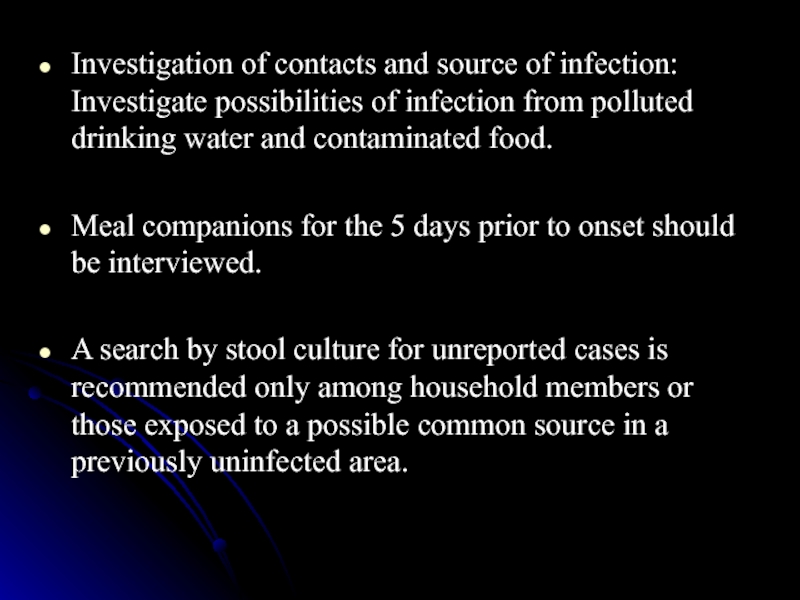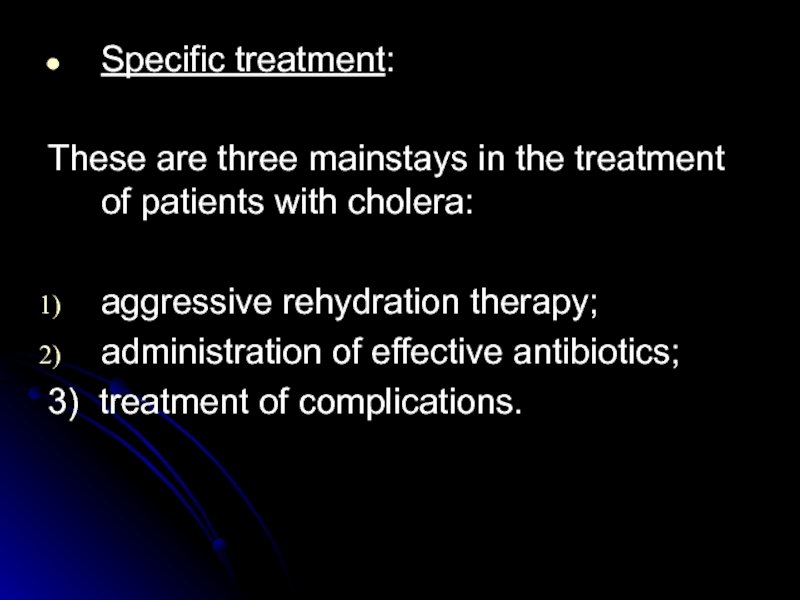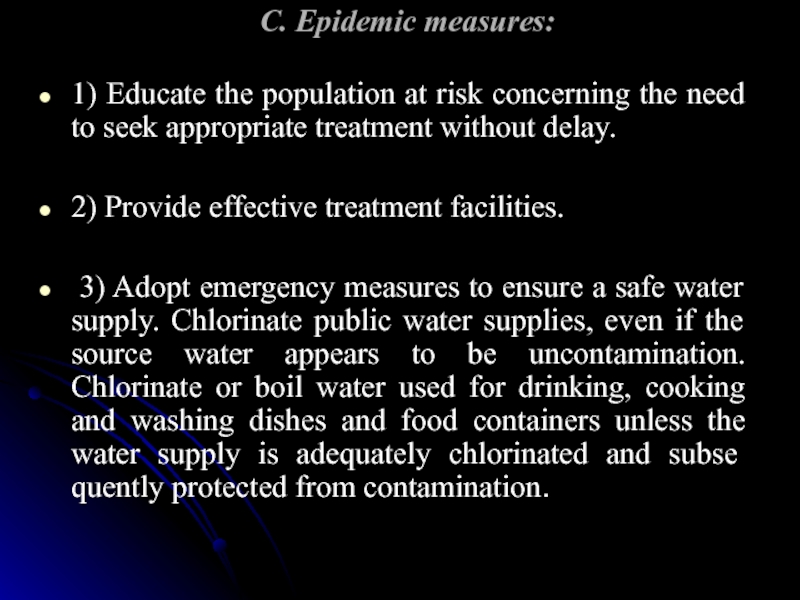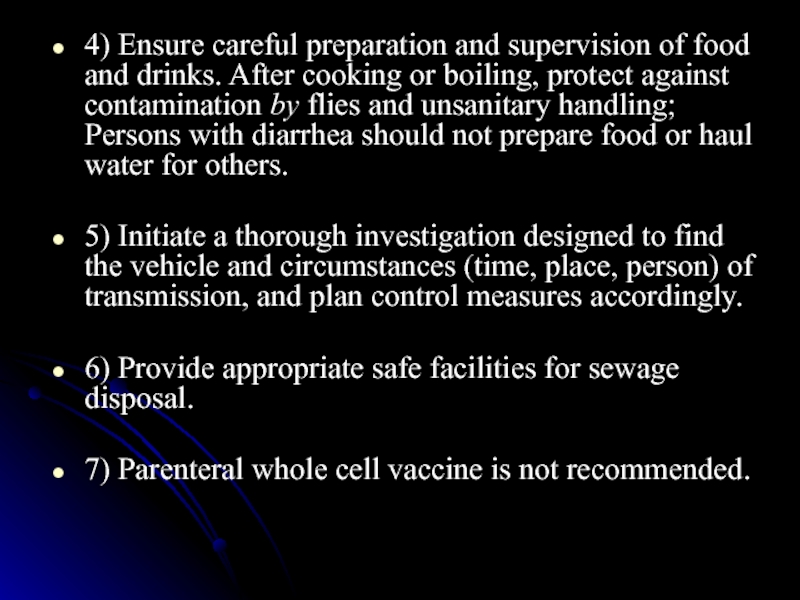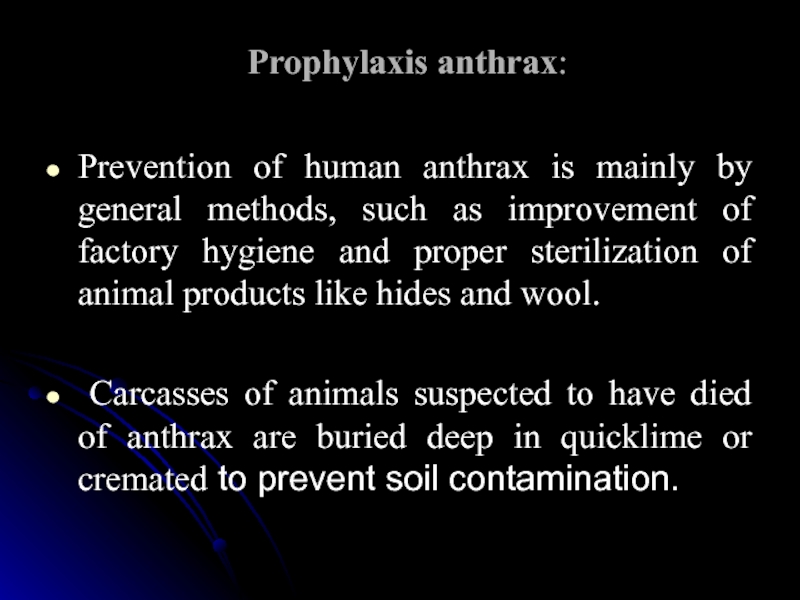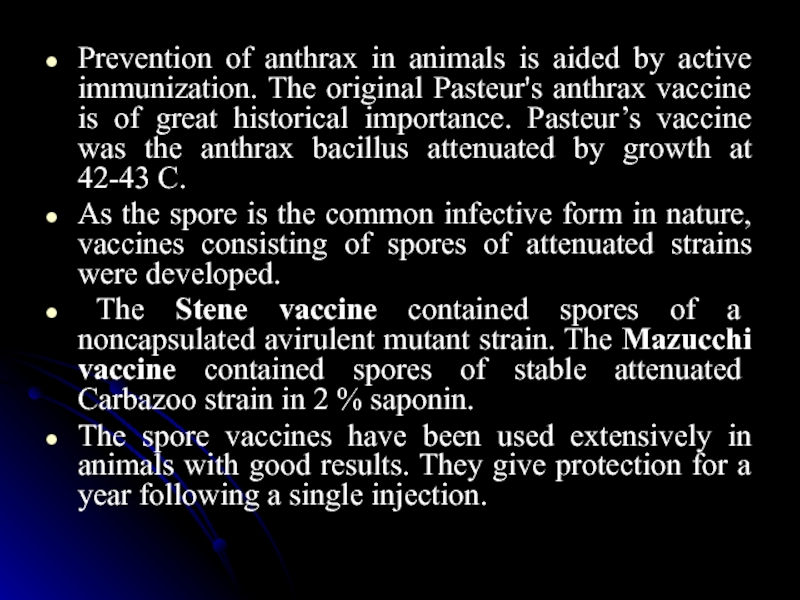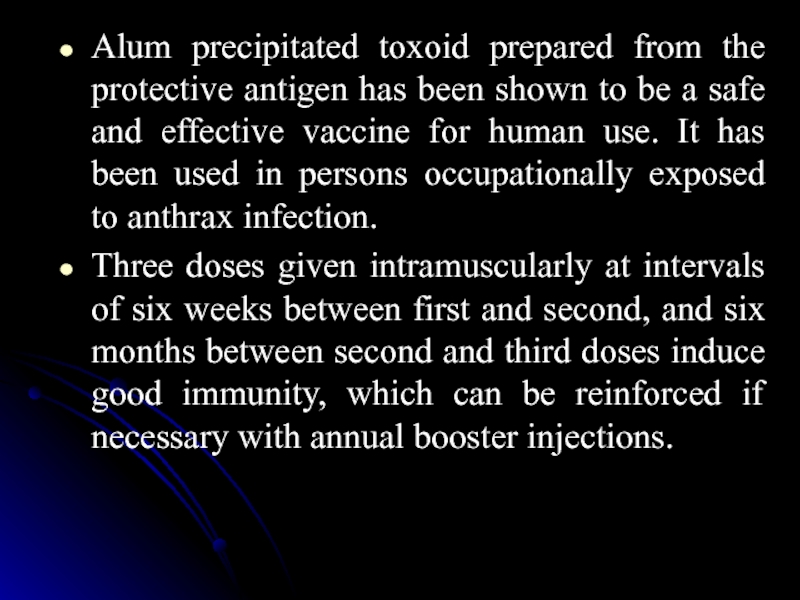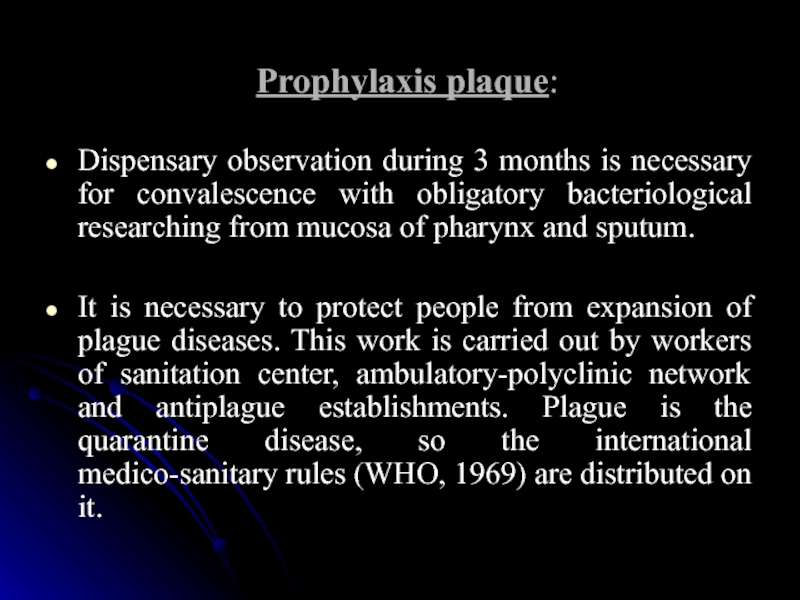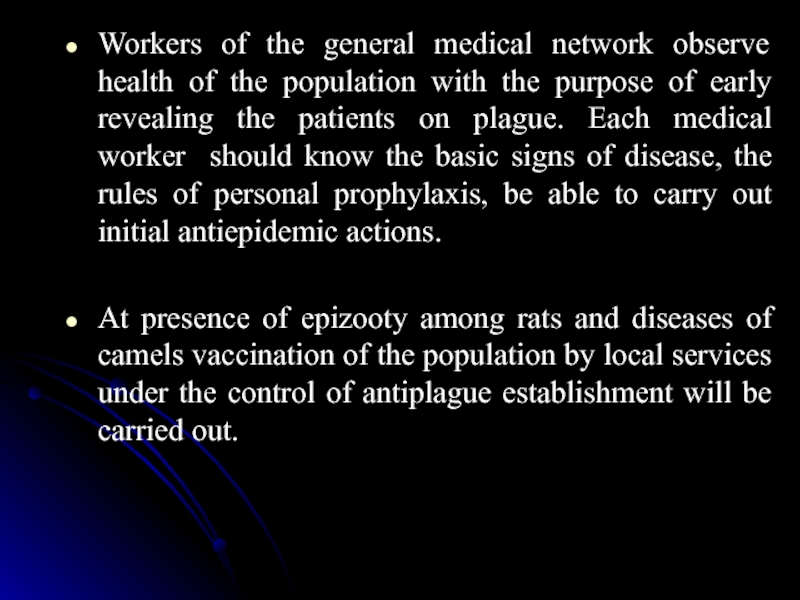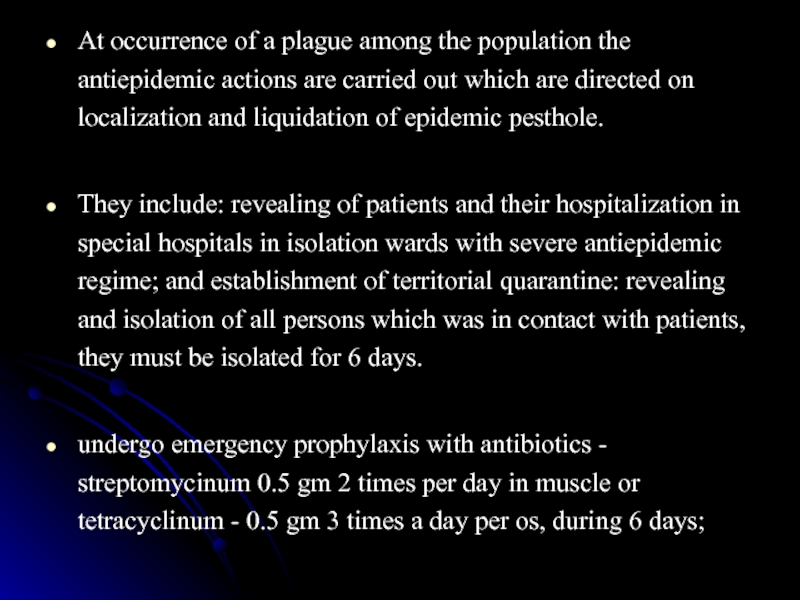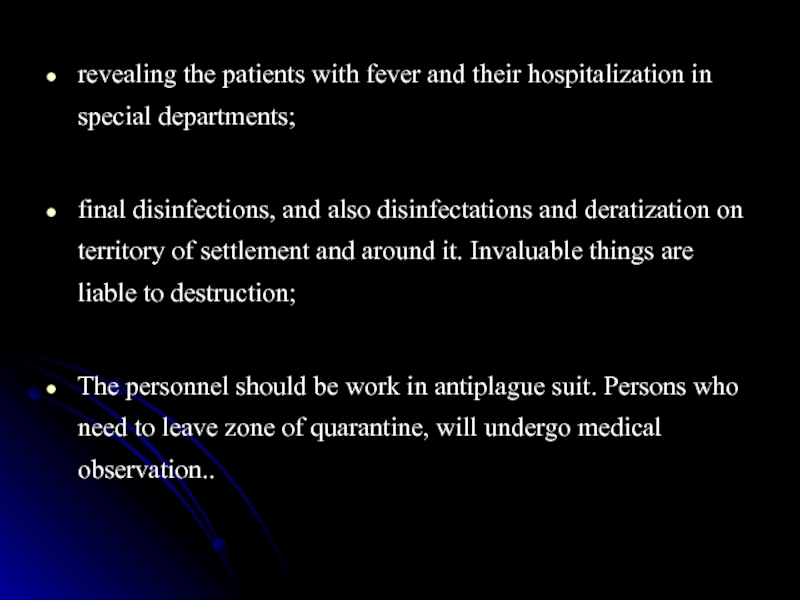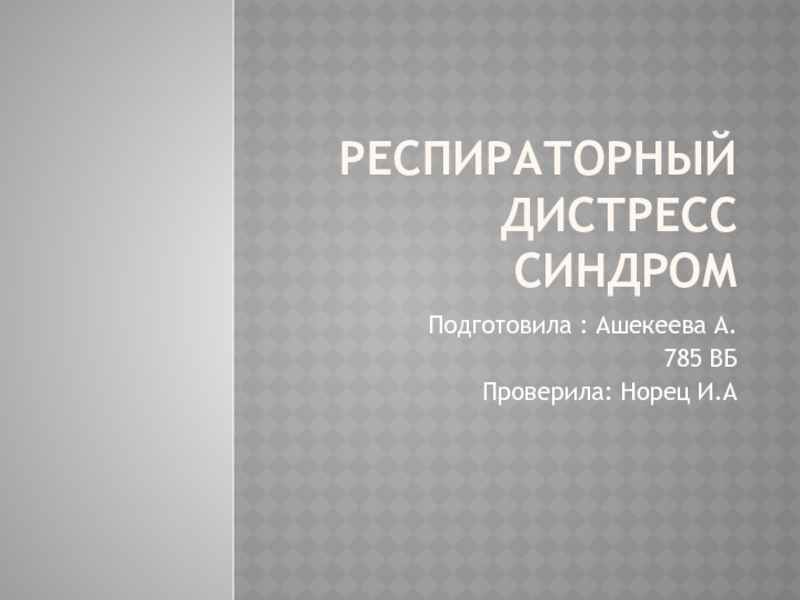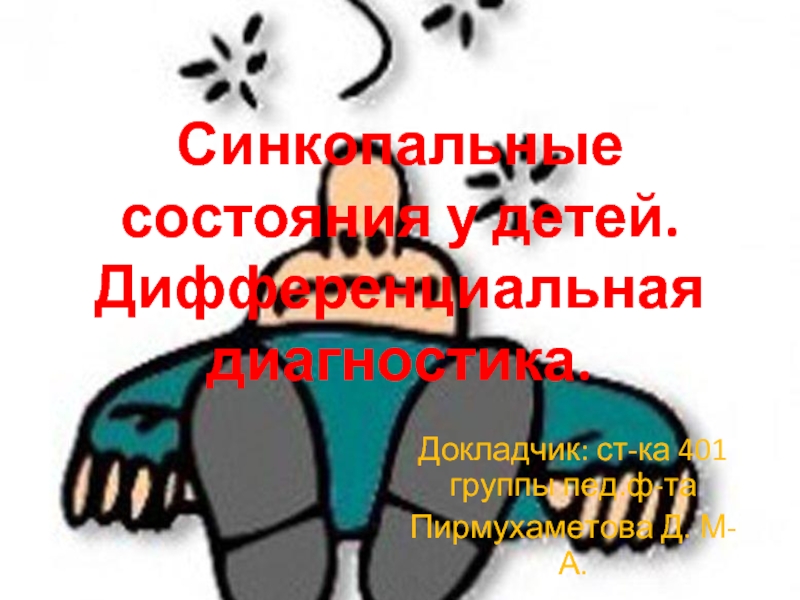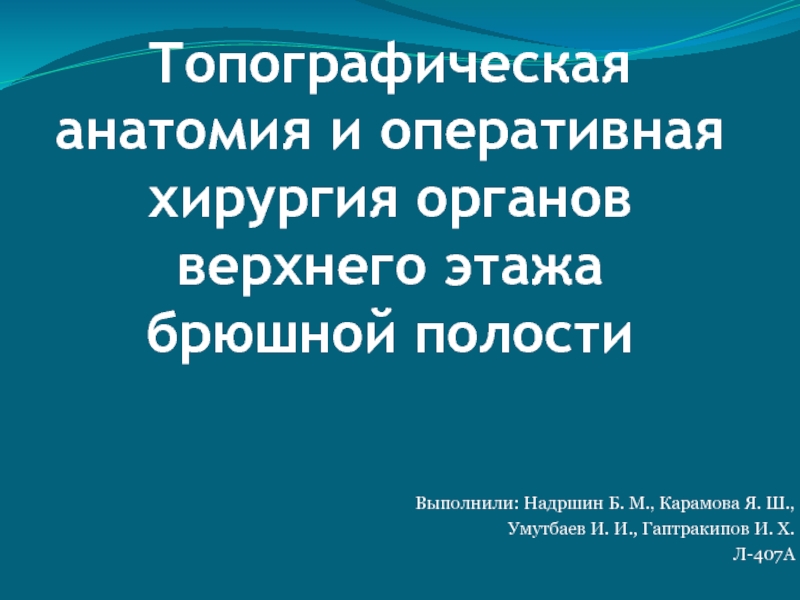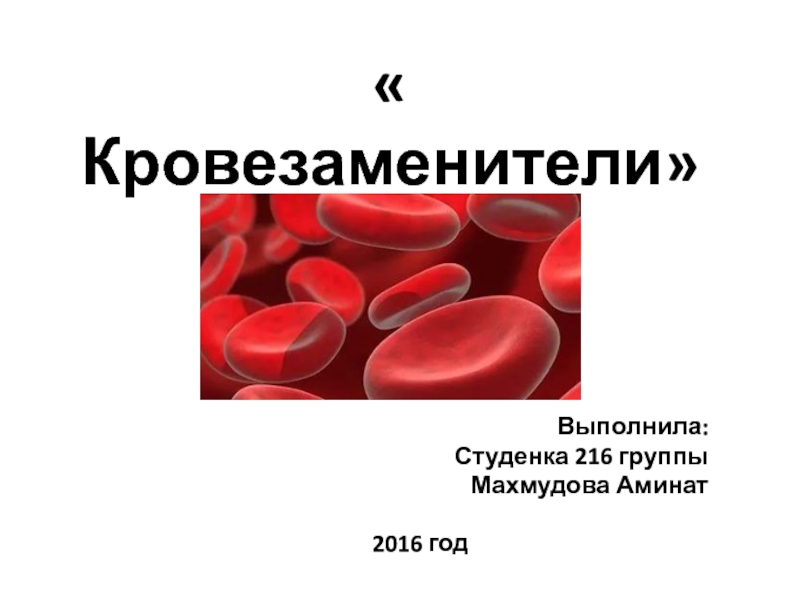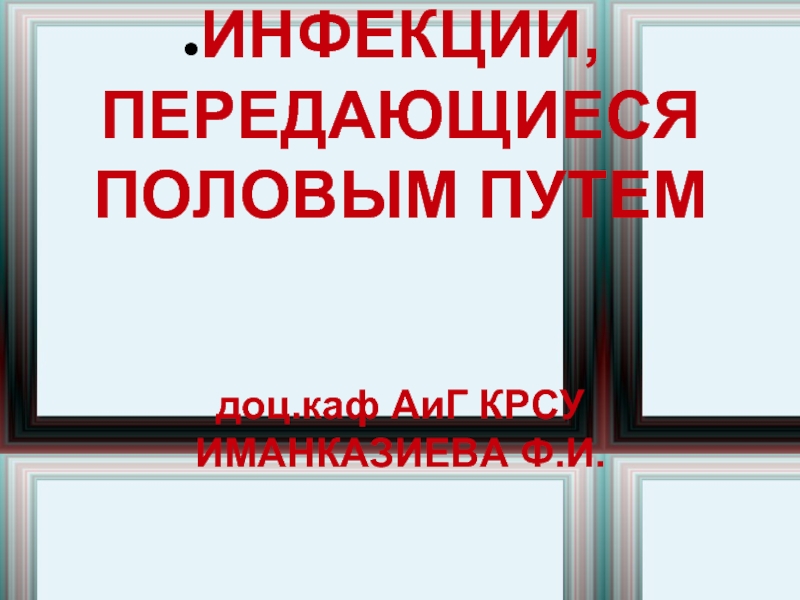- Главная
- Разное
- Дизайн
- Бизнес и предпринимательство
- Аналитика
- Образование
- Развлечения
- Красота и здоровье
- Финансы
- Государство
- Путешествия
- Спорт
- Недвижимость
- Армия
- Графика
- Культурология
- Еда и кулинария
- Лингвистика
- Английский язык
- Астрономия
- Алгебра
- Биология
- География
- Детские презентации
- Информатика
- История
- Литература
- Маркетинг
- Математика
- Медицина
- Менеджмент
- Музыка
- МХК
- Немецкий язык
- ОБЖ
- Обществознание
- Окружающий мир
- Педагогика
- Русский язык
- Технология
- Физика
- Философия
- Химия
- Шаблоны, картинки для презентаций
- Экология
- Экономика
- Юриспруденция
Prevention and control measures in particularly dangerous and quarantine infections презентация
Содержание
- 1. Prevention and control measures in particularly dangerous and quarantine infections
- 2. Plan of lecture Epidemiology features and prophylaxis
- 3. EPIDEMIOLOGY FEATURES AND PROPHYLAXIS OF
- 4. Etiology Causative agents are RNA-containing viruses.
- 5. Clinical manifestation A latent period at
- 6. The haemorrhagical syndrome appears from the 3-7th
- 7. The diagnostics Laboratory diagnostics is based
- 8. Prophylaxis Prophylactic measures are directed to the
- 9. At the revealing of patient with the
- 10. Before dressing of protective closing it is
- 11. Measures in an epidemic focus Measures of
- 12. For evacuation of one patient evacuation team
- 13. II Measures concerning the persons having
- 14. With the purpose of urgent prophylaxis serum
- 15. III Measures concerning a situation: After hospitalization
- 16. For disinfection of the apartment, articles of
- 17. Methods of control of cholerae A.
- 18. Measures that inhibit or otherwise compromise the
- 19. Quarantine: None. Can introduce restrictive measures. Monitoring
- 20. Children may also be given tetracycline (50
- 21. Investigation of contacts and source of infection:
- 22. Specific treatment: These are three
- 23. C. Epidemic measures: 1) Educate the
- 24. 4) Ensure careful preparation and supervision of
- 25. Prophylaxis anthrax: Prevention of human anthrax is
- 26. Prevention of anthrax in animals is aided
- 27. Alum precipitated toxoid prepared from the protective
- 28. Prophylaxis plaque: Dispensary observation during 3
- 29. Workers of the general medical network observe
- 30. At occurrence of a plague among the
- 31. revealing the patients with fever and their
Слайд 2Plan of lecture
Epidemiology features and prophylaxis of hemorrhagic fevers of Lassa,
Marburg,
Ebola
Measures in an epidemic focus
Measures of concern a patient
Measures concerning the persons having contacts with patients
Measures concerning a situation
Methods of control of cholera
Prophylaxis anthrax
Prophylaxis plaque
Ebola
Measures in an epidemic focus
Measures of concern a patient
Measures concerning the persons having contacts with patients
Measures concerning a situation
Methods of control of cholera
Prophylaxis anthrax
Prophylaxis plaque
Слайд 3EPIDEMIOLOGY FEATURES AND PROPHYLAXIS OF
HAEMORRAGIC FEVERS OF LASSA, MARBURG, EBOLA
The
haemorrhagic Lassa, Marburg, Ebola fevers are the zoonosis natural-antropurgenic viral infectious diseases characterized by the expressed haemorrhagical syndrome.
The haemorrhagic Lassa fever was first reveling in the north-eastern part of Nigeria in 1969 and got the name at the place of hospitalization of diseased (Lassa).
The outbreaks of the Marburg fever in 1967 appeared simultaneously among the employees of the biological laboratories in Germany (Marburg) and Yugoslavia (Belgrade), in 1976 in Zaire there was the outbreak caused by the related virus of Ebola; 358 persons became ill, from which 326 died.
The haemorrhagic Lassa fever was first reveling in the north-eastern part of Nigeria in 1969 and got the name at the place of hospitalization of diseased (Lassa).
The outbreaks of the Marburg fever in 1967 appeared simultaneously among the employees of the biological laboratories in Germany (Marburg) and Yugoslavia (Belgrade), in 1976 in Zaire there was the outbreak caused by the related virus of Ebola; 358 persons became ill, from which 326 died.
Слайд 4Etiology
Causative agents are RNA-containing viruses.
The virus of the Lassa fever
is related to the Arenaviridae family,
causative agents of the Marburg and Ebola fevers – to the Filoviridae family. Viruses are sensible to the action of chlorinated preparations, ether, chloroform
causative agents of the Marburg and Ebola fevers – to the Filoviridae family. Viruses are sensible to the action of chlorinated preparations, ether, chloroform
Слайд 5Clinical manifestation
A latent period at the Lassa and Ebola fevers
is from 2 to 21 days, at the Marburg fever – from 3 to 9 days.
The beginning of the diseases is acute, a temperature rises to 38-40°C, severe headache, myalgias, nausea appears;
at the Lassa fever is ulcerous-necrotic pharyngitis, tonsillitis, lymphadenitis;
at the Ebola fever is quinsy, affection of lungs; at the Marburg fever is vomiting, frequent watery stool with blood.
The beginning of the diseases is acute, a temperature rises to 38-40°C, severe headache, myalgias, nausea appears;
at the Lassa fever is ulcerous-necrotic pharyngitis, tonsillitis, lymphadenitis;
at the Ebola fever is quinsy, affection of lungs; at the Marburg fever is vomiting, frequent watery stool with blood.
Слайд 6The haemorrhagical syndrome appears from the 3-7th day of illness: petechias
on a skin and mucous, spotted or maculo-papular rash; nasal, gastric, uterine bleedings.
An acute period at the Lassa fever lasts for 3-4 weeks, the edemas, ascites, toxic shock, acute kidney insufficiency, develop in the seriously cases, lethality is up 20-50%.
The Marburg and Ebola fevers last for 6-14 days, at the unfavorable cases the death comes from toxic shock, cardiac weakness, cerebral disorders, lethality is from 30 to 90%.
An acute period at the Lassa fever lasts for 3-4 weeks, the edemas, ascites, toxic shock, acute kidney insufficiency, develop in the seriously cases, lethality is up 20-50%.
The Marburg and Ebola fevers last for 6-14 days, at the unfavorable cases the death comes from toxic shock, cardiac weakness, cerebral disorders, lethality is from 30 to 90%.
Слайд 7The diagnostics
Laboratory diagnostics is based on the selection of virus
from the blood, washings from nosopharynx, pleura exudation.
A virus is selected by the infection in the brain of the new-born white miсe and culture of cells.
From serological methods it is used on research of pair serum of blood.
Taking and sending of material from patients or suspicious for these diseases is done with the observance of rules of the antiepidemic mode (sterility, hermetically packing, sending with the special messenger on a separate transport),
research of this material is carried out in the special virology laboratories with the maximal degree of protection of personnel.
A virus is selected by the infection in the brain of the new-born white miсe and culture of cells.
From serological methods it is used on research of pair serum of blood.
Taking and sending of material from patients or suspicious for these diseases is done with the observance of rules of the antiepidemic mode (sterility, hermetically packing, sending with the special messenger on a separate transport),
research of this material is carried out in the special virology laboratories with the maximal degree of protection of personnel.
Слайд 8Prophylaxis
Prophylactic measures are directed to the warning of penetration of causative
agent of infection from abroad, reduction of epizootic activity of natural focus and prevention of people’s diseases in these focuses.
Protection of food and water from contamination with animal’s urine and saliva is important in natural focuses.
The sanitary guard rules of territory foresee the receipt and analysis of information about epizootic and epidemic situations in different would countries;
The medico-sanitary examination of transport coming, for example, from the focuses of the Lassa fever; revealing, isolation and treatment of patients; disinfection and, if necessary, deratization treatment of transport
Protection of food and water from contamination with animal’s urine and saliva is important in natural focuses.
The sanitary guard rules of territory foresee the receipt and analysis of information about epizootic and epidemic situations in different would countries;
The medico-sanitary examination of transport coming, for example, from the focuses of the Lassa fever; revealing, isolation and treatment of patients; disinfection and, if necessary, deratization treatment of transport
Слайд 9At the revealing of patient with the hemorrhagic fevers the Lassa,
Marburg and Ebola medical worker must work in the antiplague closing of the I-st type (before receive of protective clothing it is necessary to close a mouth and nose with a towel or mask).
Closing of the I-st type (complete protective closing) consists of: pyjamas and overalls, hood or large triangular bandage, antiplague gown, cotton-gauze mask, glasses, rubber gloves, oilskin sleeve protectors, oilskin apron, socks, knee-boot and towel.
An antiplague closing of I-st type is put, not taking off own clothes (except contamination by patient’s excretions).
Closing of the I-st type (complete protective closing) consists of: pyjamas and overalls, hood or large triangular bandage, antiplague gown, cotton-gauze mask, glasses, rubber gloves, oilskin sleeve protectors, oilskin apron, socks, knee-boot and towel.
An antiplague closing of I-st type is put, not taking off own clothes (except contamination by patient’s excretions).
Слайд 10Before dressing of protective closing it is necessary to process the
opened parts of body with a 0,5-1% chloramines' solution or 70° spirits.
Order of putting on the articles of clothing is strictly kept, and after the work the articles of antiplague clothing is had to be take off in accordance with established procedure and fold so that their “dirty” surfaces were turned inward.
Duration of continuous work in the protective clothing of the I type must not be more 3 hours (in hot time of the year – 2 hours), after it an interval for 1 hour is needed.
Order of putting on the articles of clothing is strictly kept, and after the work the articles of antiplague clothing is had to be take off in accordance with established procedure and fold so that their “dirty” surfaces were turned inward.
Duration of continuous work in the protective clothing of the I type must not be more 3 hours (in hot time of the year – 2 hours), after it an interval for 1 hour is needed.
Слайд 11Measures in an epidemic focus
Measures of concern a patient:
The primary signaling
about the revealing of patient (dead body) is carried out in three main directions: to the chief doctor of treatment-and-prophylactics establishment, the station of medical first-aid and the doctor of the proper Epidemiological station.
The medical worker revealing a patient, stay in the apartment (before arrival of evacuation team), where a patient is revealed:
by phone or through the special messenger not being in touch with a patient, informs the chief doctor of the establishment about the revealing patient and his state;
inquires the proper medicines, packing the protective clothing, means of the personal prophylaxis.
The medical worker revealing a patient, stay in the apartment (before arrival of evacuation team), where a patient is revealed:
by phone or through the special messenger not being in touch with a patient, informs the chief doctor of the establishment about the revealing patient and his state;
inquires the proper medicines, packing the protective clothing, means of the personal prophylaxis.
Слайд 12For evacuation of one patient evacuation team is needed, consisting of
a doctor and two helpers (doctor’s assistant, hospital orderly). Accompaniment of patient with relatives or acquaintances is forbidden. The employees of evacuation team must work in the protective clothing of the I-st type.
Hospitalization of a patient is conducted in the boxes of infectious hospitals with providing of hermetic condition and disconnection of ventilation. Medicare is rendered by the specially trained personnel in the protective clothing of the I-st type with the observance of the rules of the antiepidemic mode (as at the pulmonary form of plague).
The material from the patients is taken only at the place of hospitalization by the specialists of laboratories doing these examinations. Dissection of dead body and taking material from a dead body for laboratory examination is not conducted in connection with the large risk of infection. A dead body should be buried or burnt in a crematorium.
Hospitalization of a patient is conducted in the boxes of infectious hospitals with providing of hermetic condition and disconnection of ventilation. Medicare is rendered by the specially trained personnel in the protective clothing of the I-st type with the observance of the rules of the antiepidemic mode (as at the pulmonary form of plague).
The material from the patients is taken only at the place of hospitalization by the specialists of laboratories doing these examinations. Dissection of dead body and taking material from a dead body for laboratory examination is not conducted in connection with the large risk of infection. A dead body should be buried or burnt in a crematorium.
Слайд 13II Measures concerning the persons
having contacts with patients:
A medical personnel
and other persons being in the direct contact with a patient is isolated in the hermetic apartment with the disconnected ventilation to the moment of the establishment of final diagnosis or on a term equal to incubation (on the 21 day – at the Lassa and Ebola fevers; on the 9 days – at the Marburg fever).
Persons being in the direct contact with a patient have to take measures of the personal prophylaxis:
1. mucous of the mouth, nose to process by a 0,05% solution of permanganate of potassium, to wash eyes with a 1% solution of boric acid, begin to drip a 1% solution of nitric acid silver in eyes, in a nose – 1% solution of protargol;
2. additionally to rinse mouth and throat by a 70° spirits or 1% solution of boric acid.
Persons being in the direct contact with a patient have to take measures of the personal prophylaxis:
1. mucous of the mouth, nose to process by a 0,05% solution of permanganate of potassium, to wash eyes with a 1% solution of boric acid, begin to drip a 1% solution of nitric acid silver in eyes, in a nose – 1% solution of protargol;
2. additionally to rinse mouth and throat by a 70° spirits or 1% solution of boric acid.
Слайд 14With the purpose of urgent prophylaxis serum of convalescent is used.
Persons
not being in the direct contact with a patient (for example, members of evacuation team, working in the protective clothing of the I-st type), do not undergo isolations, but are subjected to the medical observation during a maximal latent period (for 21 days – at the Lassa and Ebola fevers; for 9 days – at the Marburg fever) at the place of work or place of residence.
Слайд 15III Measures concerning a situation:
After hospitalization of patient final disinfection is
conducted in a focus.
Evacuation team, after delivery of patient to the hospital has territory of hospital the complete sanitary treatment with disinfection of protective clothing.
A car, articles of care, of patient is exposed to final disinfection by forces of brigades of disinfectant.
Disinfection brigades must consist of a doctor and two disinfectors working in the protective clothing of the I-st type. All not valuable articles of everyday life are placed in dense plastic or paper sacks for further burning, remaining things are subjected to chamber treatment in steam-formalin or steam-air chambers.
Evacuation team, after delivery of patient to the hospital has territory of hospital the complete sanitary treatment with disinfection of protective clothing.
A car, articles of care, of patient is exposed to final disinfection by forces of brigades of disinfectant.
Disinfection brigades must consist of a doctor and two disinfectors working in the protective clothing of the I-st type. All not valuable articles of everyday life are placed in dense plastic or paper sacks for further burning, remaining things are subjected to chamber treatment in steam-formalin or steam-air chambers.
Слайд 16For disinfection of the apartment, articles of care of patient, protective
clothing are used a 3% chloramines solution.
At disinfection the apartment must be hermetically closed. In every apartment from a doorstep, not entering the room, a floor and air by disinfectant solution have to be irrigated.
The articles of care of patient are double wiped by a 6% peroxide of hydrogen solution, and then wet in a 3% chloramines solution for 120 minutes; a protective clothing is boiled in a 2% soda solution, then 5 l/kg is wet in a 3% chloramines solution for 120 min.
At disinfection the apartment must be hermetically closed. In every apartment from a doorstep, not entering the room, a floor and air by disinfectant solution have to be irrigated.
The articles of care of patient are double wiped by a 6% peroxide of hydrogen solution, and then wet in a 3% chloramines solution for 120 minutes; a protective clothing is boiled in a 2% soda solution, then 5 l/kg is wet in a 3% chloramines solution for 120 min.
Слайд 17Methods of control of cholerae
A. Preventive measures:
Two oral vaccines that
provide significant protection for several months against cholera caused by 01 strains have become available in a number of countries.
One is a single-dose live vaccine (strain CVD 103-HgR, available under the trade names Orahol® in Europe and Mutacol in Canada, SSVI);
the other is a nonliving vaccine consisting of inactivated vibrios plus R-subunit of the cholera toxin, given on a 2-dose schedule (Dukoral, SBL).
One is a single-dose live vaccine (strain CVD 103-HgR, available under the trade names Orahol® in Europe and Mutacol in Canada, SSVI);
the other is a nonliving vaccine consisting of inactivated vibrios plus R-subunit of the cholera toxin, given on a 2-dose schedule (Dukoral, SBL).
Слайд 18Measures that inhibit or otherwise compromise the movement of people, foods
or other goods are not justified.
B. Control of patient contacts and the immediate environment
1. Report to local health authority: Case report universally required by International Health Regulations (1969).
2. Isolation of the patient and vibriocarrier. To discharge from hospital after admission and 3-th negative bacteriological tests of feces. For the special contingent necessarily negative bacteriological test of bile.
3. Concurrent disinfection: Of feces and vomitus and of linens and articles used by patients, by heat, carbolic acid or other disinfectant. Terminal cleaning.
B. Control of patient contacts and the immediate environment
1. Report to local health authority: Case report universally required by International Health Regulations (1969).
2. Isolation of the patient and vibriocarrier. To discharge from hospital after admission and 3-th negative bacteriological tests of feces. For the special contingent necessarily negative bacteriological test of bile.
3. Concurrent disinfection: Of feces and vomitus and of linens and articles used by patients, by heat, carbolic acid or other disinfectant. Terminal cleaning.
Слайд 19Quarantine: None. Can introduce restrictive measures. Monitoring of water supply and
catering.
Management of contacts: Surveillance of persons who shared food and drink with a cholera patient for 5 days from last exposure. If there is evidence or high likelihood of secondary transmission within households, household members should be given chemoprophylaxis; in adults, tetracycline (500 mg 4 times daily) or doxycycline (a single daily dose of 300 mg) for 3 days, unless local strains are known or believed to be tetracycline resistant.
Management of contacts: Surveillance of persons who shared food and drink with a cholera patient for 5 days from last exposure. If there is evidence or high likelihood of secondary transmission within households, household members should be given chemoprophylaxis; in adults, tetracycline (500 mg 4 times daily) or doxycycline (a single daily dose of 300 mg) for 3 days, unless local strains are known or believed to be tetracycline resistant.
Слайд 20Children may also be given tetracycline (50 mg/kg/day in 4 divided
closes) or doxycycline (a single dose of 6 mg/kg) for 3 days; with such short courses of tetracyclines, staining of teeth is not a problem.
Alternative prophylactic agents that may be useful where V. cholerae 01 strains are resistant to tetracycline include: furazolidone ( Furox-one®) (100 mg 4 times daily for adults and 1.25 mg/kg 4 times daily for children); erythromycin (pediatric dosage 40 mg/kg/ day in 4 divided doses; adult dosage 250 mg 4 times daily);
Alternative prophylactic agents that may be useful where V. cholerae 01 strains are resistant to tetracycline include: furazolidone ( Furox-one®) (100 mg 4 times daily for adults and 1.25 mg/kg 4 times daily for children); erythromycin (pediatric dosage 40 mg/kg/ day in 4 divided doses; adult dosage 250 mg 4 times daily);
Слайд 21Investigation of contacts and source of infection: Investigate possibilities of infection
from polluted drinking water and contaminated food.
Meal companions for the 5 days prior to onset should be interviewed.
A search by stool culture for unreported cases is recommended only among household members or those exposed to a possible common source in a previously uninfected area.
Meal companions for the 5 days prior to onset should be interviewed.
A search by stool culture for unreported cases is recommended only among household members or those exposed to a possible common source in a previously uninfected area.
Слайд 22Specific treatment:
These are three mainstays in the treatment of patients
with cholera:
aggressive rehydration therapy;
administration of effective antibiotics;
3) treatment of complications.
aggressive rehydration therapy;
administration of effective antibiotics;
3) treatment of complications.
Слайд 23C. Epidemic measures:
1) Educate the population at risk concerning the need
to seek appropriate treatment without delay.
2) Provide effective treatment facilities.
3) Adopt emergency measures to ensure a safe water supply. Chlorinate public water supplies, even if the source water appears to be uncontamination. Chlorinate or boil water used for drinking, cooking and washing dishes and food containers unless the water supply is adequately chlorinated and subsequently protected from contamination.
2) Provide effective treatment facilities.
3) Adopt emergency measures to ensure a safe water supply. Chlorinate public water supplies, even if the source water appears to be uncontamination. Chlorinate or boil water used for drinking, cooking and washing dishes and food containers unless the water supply is adequately chlorinated and subsequently protected from contamination.
Слайд 244) Ensure careful preparation and supervision of food and drinks. After
cooking or boiling, protect against contamination by flies and unsanitary handling; Persons with diarrhea should not prepare food or haul water for others.
5) Initiate a thorough investigation designed to find the vehicle and circumstances (time, place, person) of transmission, and plan control measures accordingly.
6) Provide appropriate safe facilities for sewage disposal.
7) Parenteral whole cell vaccine is not recommended.
5) Initiate a thorough investigation designed to find the vehicle and circumstances (time, place, person) of transmission, and plan control measures accordingly.
6) Provide appropriate safe facilities for sewage disposal.
7) Parenteral whole cell vaccine is not recommended.
Слайд 25Prophylaxis anthrax:
Prevention of human anthrax is mainly by general methods, such
as improvement of factory hygiene and proper sterilization of animal products like hides and wool.
Carcasses of animals suspected to have died of anthrax are buried deep in quicklime or cremated to prevent soil contamination.
Carcasses of animals suspected to have died of anthrax are buried deep in quicklime or cremated to prevent soil contamination.
Слайд 26Prevention of anthrax in animals is aided by active immunization. The
original Pasteur's anthrax vaccine is of great historical importance. Pasteur’s vaccine was the anthrax bacillus attenuated by growth at 42-43 C.
As the spore is the common infective form in nature, vaccines consisting of spores of attenuated strains were developed.
The Stene vaccine contained spores of a noncapsulated avirulent mutant strain. The Mazucchi vaccine contained spores of stable attenuated Carbazoo strain in 2 % saponin.
The spore vaccines have been used extensively in animals with good results. They give protection for a year following a single injection.
As the spore is the common infective form in nature, vaccines consisting of spores of attenuated strains were developed.
The Stene vaccine contained spores of a noncapsulated avirulent mutant strain. The Mazucchi vaccine contained spores of stable attenuated Carbazoo strain in 2 % saponin.
The spore vaccines have been used extensively in animals with good results. They give protection for a year following a single injection.
Слайд 27Alum precipitated toxoid prepared from the protective antigen has been shown
to be a safe and effective vaccine for human use. It has been used in persons occupationally exposed to anthrax infection.
Three doses given intramuscularly at intervals of six weeks between first and second, and six months between second and third doses induce good immunity, which can be reinforced if necessary with annual booster injections.
Three doses given intramuscularly at intervals of six weeks between first and second, and six months between second and third doses induce good immunity, which can be reinforced if necessary with annual booster injections.
Слайд 28Prophylaxis plaque:
Dispensary observation during 3 months is necessary for convalescence
with obligatory bacteriological researching from mucosa of pharynx and sputum.
It is necessary to protect people from expansion of plague diseases. This work is carried out by workers of sanitation center, ambulatory-polyclinic network and antiplague establishments. Plague is the quarantine disease, so the international medico-sanitary rules (WHO, 1969) are distributed on it.
It is necessary to protect people from expansion of plague diseases. This work is carried out by workers of sanitation center, ambulatory-polyclinic network and antiplague establishments. Plague is the quarantine disease, so the international medico-sanitary rules (WHO, 1969) are distributed on it.
Слайд 29Workers of the general medical network observe health of the population
with the purpose of early revealing the patients on plague. Each medical worker should know the basic signs of disease, the rules of personal prophylaxis, be able to carry out initial antiepidemic actions.
At presence of epizooty among rats and diseases of camels vaccination of the population by local services under the control of antiplague establishment will be carried out.
At presence of epizooty among rats and diseases of camels vaccination of the population by local services under the control of antiplague establishment will be carried out.
Слайд 30At occurrence of a plague among the population the antiepidemic actions
are carried out which are directed on localization and liquidation of epidemic pesthole.
They include: revealing of patients and their hospitalization in special hospitals in isolation wards with severe antiepidemic regime; and establishment of territorial quarantine: revealing and isolation of all persons which was in contact with patients, they must be isolated for 6 days.
undergo emergency prophylaxis with antibiotics - streptomycinum 0.5 gm 2 times per day in muscle or tetracyclinum - 0.5 gm 3 times a day per os, during 6 days;
They include: revealing of patients and their hospitalization in special hospitals in isolation wards with severe antiepidemic regime; and establishment of territorial quarantine: revealing and isolation of all persons which was in contact with patients, they must be isolated for 6 days.
undergo emergency prophylaxis with antibiotics - streptomycinum 0.5 gm 2 times per day in muscle or tetracyclinum - 0.5 gm 3 times a day per os, during 6 days;
Слайд 31revealing the patients with fever and their hospitalization in special departments;
final disinfections, and also disinfectations and deratization on territory of settlement and around it. Invaluable things are liable to destruction;
The personnel should be work in antiplague suit. Persons who need to leave zone of quarantine, will undergo medical observation..
